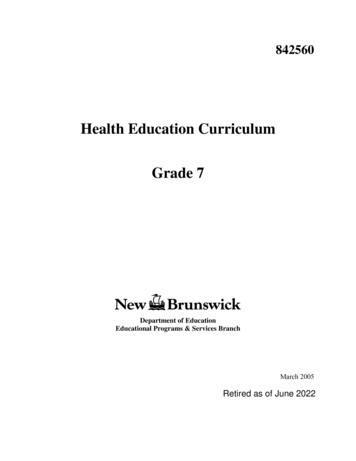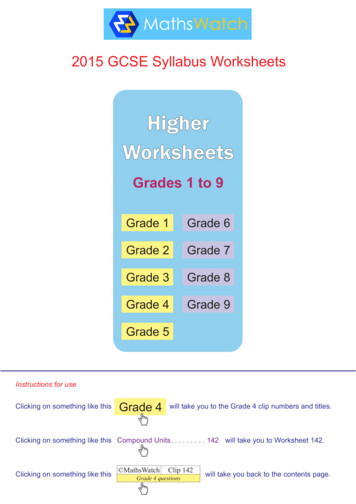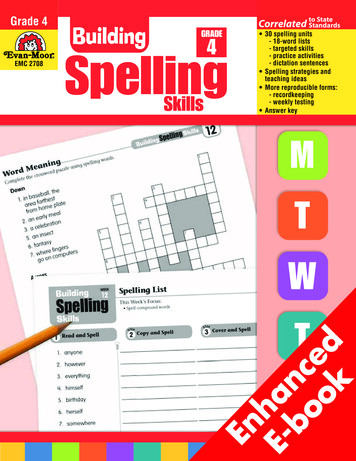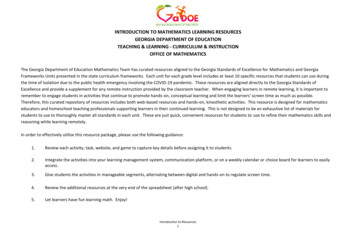
Transcription
842560Health Education CurriculumGrade 7Department of EducationEducational Programs & Services BranchMarch 2005Retired as of June 2022
Please NoteThe Health Education Curriculum Grade 7 document developed by the EducationalPrograms & Services Branch of the Department of Education is intended for use bythe teachers who will be delivering the health curriculum in their school.The expectation of the curriculum is that students will achieve the Outcomes asdetailed in the curriculum document.The Learning and Teaching Suggestions, and Appendices that support theOutcomes, provide options from which the teacher may select. As with delivery ofall provincial curricula, teachers will exercise professional judgement in theselection of learning activities and tailor them to the needs of their students. Theappendices will be selected and used in a manner the teacher deems appropriate forhis/her class and community.This document is not a text book for use by students. It is a document that teachersare expected to use to guide the delivery of the Middle School Health EducationCurriculum.
ACKNOWLEDGMENTSThe Department of Education acknowledges, with appreciation, the many dedicated educatorswho gave their time and energy to develop this curriculum. Without their input, this documentwould not be as rich and locally meaningful.Elizabeth NowlanSchool District 02Anne-Marie DuguaySchool District 06Norma ShawSchool District 14Jean MacIntyreSchool District 17Donna DawkinsSchool District 18Silvy MolemanWorkplace Health, Safety and CompensationCommissionMark HollandDepartment of EducationDianne KayDepartment of EducationMargie Layden-OretoDepartment of EducationKeith McAlpineDepartment of EducationMaureen MacIntoshPublic Health Nurse, Healthy Learners ProgramNancy McKeil-PerkinsPublic Health Nurse, Healthy Learners ProgramMarlien McKayDepartment of Health and WellnessDr. Mary McKennaUniversity of New BrunswickHEALTH EDUCATION CURRICULUM GRADE 7i
iiHEALTH EDUCATION CURRICULUM GRADE 7
TABLE OF CONTENTSVISION FOR HEALTH EDUCATION .1RATIONALE .1INTRODUCTION.1Purpose of the Document . 1Comprehensive School Health . 2Curriculum Focus . 3Abstinence Statement . 3OUTCOMES .5Essential Graduation Learnings (EGLs). 5Health Curriculum At A Glance: Summary of Learning Outcomes for 6-8 . 6General Curriculum Outcomes for Health Education . 7Information Letter For Parents/Guardians. 9GRADE 7 OUTCOMES. 11APPENDICES – GRADE 7Appendix 7.1 – Wellness Wheel Activity – Outcome B1 . 33Appendix 7.2 – Healthy Food Choices – Outcome B2 . 37Appendix 7.3 – The Real Scoop on Tobacco – Outcome C1. 39Appendix 7.4 – No Means No – Outcome C1. 40Appendix 7.5 – Scenarios – Outcome C2 . 42Appendix 7.6 – Take a Tobacco Tour Through Town – Outcome C3. 43Appendix 7.7 – Thinking Like a Tobacco Company – Outcome C3 . 44Appendix 7.8 – Teaching Tips – Growth & Development Outcomes . 63Appendix 7.9 – Your Identity – Many Parts Make You Strong – Outcome D1 . 64Appendix 7.10 – Me – Outcome D1 . 67Appendix 7.11 – The Menstrual Cycle – Outcome D2 . 68Appendix 7.12 – Male Reproductive System – Outcome D2 . 69Appendix 7.13 – Menstruation and Sperm Production – Outcome D2. 70Appendix 7.14 – Sperm Production – Outcome D2 . 71Appendix 7.15 – Menstruation and Sperm Production – Outcome D2. 72Appendix 7.16 – Who’s Who Vocabulary Worksheet – Outcome D2. 73Appendix 7.17 – Words About Fertilization and Pregnancy – Outcome D3 . 75Appendix 7.18 – Childbirth – Outcome D3 . 77Appendix 7.19 – Genetics – Sex Determination – Outcome D3. 78Appendix 7.20 –Twins – Outcome D3. 79Appendix 7.21 – Eco Map – Outcome D4 . 81Appendix 7.22 – Zaney’s Story – Outcome D4 . 82Appendix 7.23 – It’s Okay to Say No – How Would You Refuse? – Outcome D4. 83Appendix 7.24 – It’s Okay to Say No – Saying No Role Plays – Outcome D4. 84Appendix 7.25 – You Decide – Outcome D4. 85Appendix 7.26 – How Do I Know When – Outcome D4. 86Appendix 7.27 – Decision-Making Skills – Outcome D4. 88TEACHER RESOURCESPrint Resources for Teachers. 89Websites for Teachers . 91Legal Status . 93HEALTH EDUCATION CURRICULUM GRADE 7iii
ivHEALTH EDUCATION CURRICULUM GRADE 7
VISION FOR HEALTH EDUCATION"Students will leave public education both understanding and practising wellness,by making wise lifestyle choices which contribute to the development of not only ahealthy, caring individual but also to the community."(From "Desired Outcomes for Health Education in NB Schools,"developed by the Health Foundation Group, 1997)RATIONALEAs family structures continue to change, health and social delivery systems need to adopt newroles. "While schools alone cannot be expected to address the health and related social problemsof youth, they can provide, through their climate and curriculum, a focal point for efforts toreduce health-risk behaviours and improve the health status of youth." ("Health Is Academic,"1996, p. 9)This curriculum contributes to fostering improved health, recognizing that there are many factorsthat promote health at every stage of a child’s development. Every child should be encouragedto maximize his/her health.Healthy children are more productive and capable students. Positive health habits adopted earlyin life decrease the risk of disease among adults. While there are many children with positivehealth profiles in New Brunswick, there are also significant health concerns.INTRODUCTIONPurpose of the DocumentDuring the 1996-97 school year, the Department of Education convened a group representingmany different sectors. This group designed a foundation for Health Education in Englishschools; this health curriculum document has been based on this foundation. The NewBrunswick Department of Education collaborated with the University of New Brunswick toconduct parallel surveys of teachers, parents, middle school students and high school studentsconcerning their ideas about sexual health education. The survey results are available atwww.gnb.ca/0000/pub alpha-e.asp under the titles New Brunswick Parents’ Ideas About SexualHealth Education, New Brunswick Students’ Ideas About Sexual Health Education and NewBrunswick Teachers’ Ideas About Sexual Health Education.This document gives detailed information about the curriculum for Health Education in NewBrunswick schools: outcomes for knowledge, skills and attitudes; suggestions for learning andassessment activities, and resources. It is expected that students will have the opportunity toreach learning outcomes for health at each level between grades six and eight.HEALTH EDUCATION CURRICULUM GRADE 71
Comprehensive School Health (CSH)This document is intended to support the implementation of the Comprehensive School Healthmodel in the public schools of New Brunswick. CSH is an integrated approach to health thatincorporates instruction, services and supports, and the school environment. This model extendscurriculum further than has traditionally been the case. Students are expected to fully meet theirindividual potential, contribute to community and pursue wellness.They will acquireknowledge, skill development, and the development of attitudes and behaviours that aresupported by activities and services within the schools and their communities. This curriculumis developed in recognition that health is a shared responsibility among individuals, families,schools and communities.ENVIRONMENTINSTRUCTIONthe physical, emotionaland social climate ofschools, families andcommunitiesHEALTHprovides opportunitiesfor students to acquireknowledge, attitudesand skills to live ahealthy lifephysical, social,psychological,emotional andspiritualSERVICES ANDSUPPORTpeople and programsthat support studenthealth2HEALTH EDUCATION CURRICULUM GRADE 7
Curriculum FocusThere are many factors that promote health at every stage of a child’s development. Thefollowing four strands in this curriculum were chosen to represent and to organize diversefactors. Caring for Yourself, Your Family and Your CommunityPersonal WellnessUse, Misuse and Abuse of Materials (emphasizing Media Literacy)Physical Growth and DevelopmentThroughout the curriculum students are encouraged to be positive and proactive in maintaining aphysical, emotional, and psychological well-being. These strands allow students to consider theirdevelopment both at a personal level and within the context of their communities.As with the Comprehensive and Developmental Guidance Program, it is important to provideeach student with the skills to analyse a set of circumstances and plan a course of action toachieve a goal. It is impossible to study every potential circumstance in which students may findthemselves, but it is essential to provide students with the tools to make healthy choices. It isdesirable for a student to appreciate conditions, plan action, determine possible consequencesand make a decision with respect to a given health issue.Research indicates that individuals build improved conceptual understanding by blending newknowledge with prior knowledge and experience. Understanding and decision-making skills areimproved when study takes place in a meaningful context.This curriculum is intended to be taught in an inclusive co-educational setting; however, incertain situations flexible grouping options may be considered.Abstinence StatementThe Growth and Development strand of the New Brunswick Health EducationCurriculum emphasizes that abstinence from all sexual activity that involves riskis the best and only truly safe health choice for adolescents. Students who dodecide to become sexually active now or in the future need information about theeffective use of protection against pregnancy and sexually transmitted infections.Classes do not encourage students to become sexually active nor do they includeteaching about sexual techniques.HEALTH EDUCATION CURRICULUM GRADE 73
The following diagram illustrates the integration of Comprehensive School Health (CSH) andthe four strands of the Health Curriculum. The areas listed under “Environment” and “Servicesand Support” are intended as examples to illustrate potential connections using this model.Caring for Yourself, Your Family and Your CommunityStudents will demonstrate an understanding of and practise skills toenhance personal safety, prevention of illness, the safety of othersand protection of the environment.Environment Helmetlegislation Laws againstabuse Air quality Smoke-freepublic places PositiveLearningEnvironment Acceptanceand diversity CSH juryprevention5 RsPositivedecisionmakingEnvironment PositiveLearningEnvironment SchoolNutritionPolicies Playgroundfacilities Smoke-freepublicplacesbylawsCSHServices andSupport Medicalchecks Thememonths; e.g.Nutritionmonth HealthyLearnersProgram IntramuralsServices andSupportBlock ParentsKids Help LineDestinationConservationRCMPWHSCCSt. JohnAmbulanceGrowth and DevelopmentStudents will demonstrate an understanding of body systems, growthand development, and apply this knowledge in ways thatcontribute positively to physical, social and emotional growth.Environment Scent-freepolicy PositiveLearningEnvironmentPersonal WellnessStudents will demonstrate an understanding of all dimensionsof health and well-being and make informed decisionsthat contribute to an active, healthy lifestyle.CSHServices and Support Healthy LearnersNurses Regional SexualHealth Centres Guidance programInstruction 5 senses Physicalchanges &growth Bodysystems Hygiene Individualdifferences DecisionmakingUse, Misuse and Abuse of Materials (emphasizing Media Literacy)Students will understand the effects of substanceuse and misuse (media literacy) and make healthy,well-informed decisions.Environment Smoking, drug& alcohollaws Advertisingregulations(re: marketingto children) PositiveLearningEnvironment Diet IndustryCSH 4Instruction Healthylifestyleactivities Tobaccouseprevention Nutrition Body image Emotionalwell-being PhysicalEducationInstruction Consumersafety Advertising Drugs /Alcohol /Tobacco Refusalskills PositivedecisionmakingServices andSupportRCMPAddiction ServicesHealthorganizationsDept. of ConsumerAffairsHEALTH EDUCATION CURRICULUM GRADE 7
OUTCOMESEssential Graduation Learnings (EGLs)Atlantic Canada has defined six essential learnings by which graduates of public education willbe able to demonstrate knowledge, skills and attitudes.The essential learning related to personal development requires that students be able to continuelearning and pursue an active, healthy lifestyle. It can be argued that young adults who have apoor understanding of wellness and whose physical and psychological health is compromised areless able to enjoy success with other essential learnings. It is intended that students demonstrateabilities related to aesthetic expression, citizenship, communication, problem solving andtechnological competence. People differ in talents, abilities and interests; however, recent brainresearch indicates that any child will realize improved thinking and motor skills when he/she isprovided with good nutrition, experiences daily physical activity and is given the opportunity topractise new tasks and skills.Aesthetic ExpressionGraduates will be able to respond with critical awareness to various forms of the arts and be ableto express themselves through the arts.CitizenshipGraduates will be able to assess social, cultural, economic, and environmental interdependencein a local and global context.CommunicationGraduates will be able to use the listening, viewing, speaking, reading, and writing modes oflanguage(s) as well as mathematical and scientific concepts and symbols to think, learn, andcommunicate effectively.Personal DevelopmentGraduates will be able to continue to learn and to pursue an active, healthy lifestyle.Problem SolvingGraduates will be able to use the strategies and processes needed to solve a wide variety ofproblems, including those requiring language, mathematical, and scientific concepts.Technological CompetenceGraduates will be able to use a variety of technologies, demonstrate an understanding oftechnological applications, and apply appropriate technologies for solving problems.HEALTH EDUCATION CURRICULUM GRADE 75
Health Curriculum at a Glance: Summary of Learning Outcomes for 6-8Grade6Caring for Yourself,Your Family and YourCommunityStudents will be able toA1) identify injuries thatare prevalent in thecommunityA2) identify and describevariousenvironmentalfactors that affectour health7A1) define the role ofcommunitymembers (includingself) in promotingsafety and injurypreventionA2) describe selectedexamples ofinfectious and noninfectious disease,identifying theirdetection andprevention8A1) identify therelationship betweenhigh-risk behavioursand resultingconsequencesA2) identify and describehow to promotesafety and preventinjury or illnessPersonal WellnessStudents will be abletoB1) describe thedomains ofwellness andidentifystrategies forpromoting theirown wellnessB2) identify strategiesfor promotingnutrition andphysical activityB3) identify howenvironmentsinfluence healthchoicesB4) identify howadvertisementsare used topromote healthB1) identify strategiesfor promotingtheir ownwellnessB2) identify needspertaining tostudent wellnessin schoolB3) describe theprocess requiredto implement andevaluate a changethat improvesstudent wellnessin schoolB1) identify strategiesfor promotingtheir ownwellnessB2) identify factorsthat enhancehealth or thatcause illnessB3) identify stressorsin students’ livesand strategies forcoping withstressUse, Misuse and Abuse ofMaterials (emphasizing MediaLiteracy)Students will be able toStudents will be able toC1) demonstrate knowledge of andrespect for people withsensitivities or allergiesD1) understand the changesthat occur in the bodyduring pubertyC2) explain the use and misuse ofsubstances which may assistweight loss or body buildingD2) understand the structuresand functions of male andfemale reproductivesystemsC3) define what is meant byaddictive behaviours anddiscuss why some individualsare more prone to addictionsC1) identify and describe thenegative effects of alcohol anddrugsC2) identify, describe and practiserefusal skills in order to takepersonal responsibilityC3) identify and analyse influences,especially from peers andmedia/promotions, that impacton choices regarding healthy orunhealthy behaviours (eg.smoking, drinking, dieting)C1) understand what an addiction isand how it can make a personkeep doing somethingunhealthy or destructiveC2) practice positive decisionmaking as it relates to self andothersC3) identify and value themselves aspositive role modelsC4) recognize that most adolescentsdo not engage in unhealthybehaviours or activitiesGrowth and DevelopmentD3) understand thatsexuality is anexpression of one’s“femaleness” or“malenessD1) understand that sexualityintegrates many aspectsof each of our livesD2) review the structure andthe function of the maleand femalereproductive systemsD3) describe fertilization,pregnancy andchildbirthD4) recognize and evaluatedifferent kinds ofrelationshipsD1) understand the role of themedia in establishingfeelings and attitudesabout ourselves andrelationships with others,including dating andbecoming sexually activeD2) understand the choicesand realize both the longand short-termconsequences andresponsibilities that existwith becoming sexuallyactiveD3) discuss sexualorientation issues6HEALTH EDUCATION CURRICULUM GRADE 7
General Curriculum Outcomes for Health EducationThree General Curriculum Outcomes connect the framework to specific learning outcomes ateach grade level. Experiences at any stage of the learning continuum will contribute to achievingthe general curriculum outcomes, which comprise knowledge, skills and attitudes about healthand wellness.KnowledgeAs children develop, it becomes important that they understand what changes they willexperience personally and those they will see in others. An awareness of potentially harmfulfactors, and ways to minimize risk, is knowledge that promotes wellness.SkillsKnowledge alone is insufficient to develop good health. Decision making is a skill emphasizedthroughout this curriculum. In order to minimize risk (from harm) it is important that studentsidentify information, assess that which is relevant, then act on the basis of an informed decision.Wisdom is based on experience, which suggests students need simulations through which topractise decision-making skills and the assessment and evaluation of the consequences. AsDewey stated, "Children learn by doing."AttitudesEach person develops attitudes and beliefs that are shaped by personal experience andfamily/cultural background. In a democratic society, people enjoy freedom of beliefs but share aresponsibility to ensure that pursuing one’s beliefs and actions does not harm other members ofsociety. Learning outcomes in health encourage students to appreciate a range of beliefs andattitudes and the impact they may have for an individual and for society. This curriculum isdesigned to assist students in developing attitudes which benefit both themselves and theircommunity.Elaborations are intended to provide examples to clarify the outcomes.encompassing.HEALTH EDUCATION CURRICULUM GRADE 7They are not all-7
The chart below represents the two-page format found in this document. This format isconsistent throughout all four strands; however, the Growth and Development strand hasextensive support material provided as appendices. This additional material is provided tofacilitate ease and consistency of delivery.Right PageLeft PageSpecific CurriculumOutcome StatementSuggestions forLearning andTeachingSuggestions forAssessmentResourcesLegendIn order to assist teachers with class preparation, the following symbols on the left, when used inthe curriculum document, alert the teacher to the information on the right. Sensitive TopicResources included in theTeacher’s KitThe information is printed in ItalicsTeacher NoteLink To Another Curriculum8HEALTH EDUCATION CURRICULUM GRADE 7
SAMPLEInformation Letter for FamiliesPrinted on School LetterheadDear Families:We are pleased to inform you that we will be teaching the prescribed Health Education Curriculum, Grade7. The curriculum consists of four strands shown on the attached page entitled HealthCurriculum at a Glance: Summary of Learning Outcomes for Grades 6-8. For more information on thecurriculum documents, please go to the following links: Grade 6 Health; Grade 7 Health or Grade 8Health.Keeping children safe and healthy is of great importance to both parents and educators. Healthy studentsare better learners and are more likely to grow up to be healthy, happy adults. The intent of the curriculumis to assist and support parents in teaching their children knowledge and skills to promote health. All ofthe information is developmentally appropriate for children and builds on what they have learned inprevious grades. The curriculum supports the development of skills to make healthy choices.Families play an integral role in their child’s education, and this is particularly important when the learninginvolves sexuality and sexual health. Schools address these topics to ensure that all learners haveaccess to factual, accurate information about health and well-being and learn the skills to make safe andresponsible decisions. This curriculum will not replace the role of parents/guardians in educating theirchildren on sexuality and sexual health.I encourage you to talk with your children about what they are learning in class and to contact me (insertcontact info here) if you require further information. Your interest and support are greatly appreciated.Appreciatively,9HEALTH EDUCATION CURRICULUM GRADE 7
10HEALTH EDUCATION CURRICULUM GRADE 7
Grade 7 Outcomes
SETTING THE SCENE - GRADE 7This introductory lesson is intended to set the stage for Health Education in Grade 7.The correct terminology for all parts of the body should be used. If students use alternativeterms, teachers are advised to clarify the discussion by relating the correct terminology.The following are questions to guide teacher and student reflection when using the curriculum.The discussion should focus on adolescent health.What is health?What are the components of health?What does it mean to be healthy?What are the short-and long-term benefits of being healthy?What influences our health?What does it mean to promote health?Who in our society is responsible for health and for health promotion?What actions can individuals and groups take to promote health?What careers are available in the health cluster?Day One – How To Get StartedOutcomeStudents will be able toidentify how belonging to agroup can influence one’shealth in a positive and/ornegative way.Learning and Teaching SuggestionsThe teacher leads a discussion and, using an example such as a“youth group,” the class discusses the potential influence thegroup has regarding the members’ health.Using the Trading Card Technique, the class generates ideas onhow belonging to a group can influence one’s health in a positive(relationships, experience safe environments) and/or negative(gang allegiance, peer pressure and risky behaviours) way. Theteacher provides each student with two index cards. On one cardeach student will identify a group and its positive influence onhealth. On the second card each is to identify a group and itsnegative influence on health. Students are not to put their nameson the cards; anonymity works well when you think an individualmay have reasons not to disclose information to the entire group.The teacher collects the cards, shuffles them and redistributes thecards to the class. Working in small groups, students discuss theinformation on the index cards and identify what makes a grouphealthy versus unhealthy. One person reports to the entire class orplaces information on class flip chart.Reminder: A sample letter to parents is included in the introductionHEALTH EDUCATION CURRICULUM GRADE 711
Grade 7 – A. Caring for Yourself, Your Family and Your CommunityOutcomesBy the end of grade 7,students will be expected toA1) define the role ofcommunity members(including self) inpromoting safety andinjury preventionElaborationIidentify risky behavioursand consequences;encourage personalresponsibility; developcommunity support;consider accessibility offacilities (for those withexceptionalities); considervolunteering in thecommunity.Learning and Teaching SuggestionsConsider a class discussion of risky behaviours and their consequences. Havestudents share an example of risky behaviour and their perception of the risk factor.It is important to emphasize the broad consequences of personal choices (on self andothers). Encourage students to help peers recognize that some behaviours are highrisk.Brainstorm with students to generate a list of potential community members who areinvolved in the promotion of safety. Include such issues as how safe are buildings forpersons with exceptionalities. Students could investigate such buildings for theeffectiveness and safety of accessibility modifications (ramps, fire exits, sidewalks,doors, washroom facilities). Once a list has been generated, schedule personal ortelephone interviews with these resource people. Have students create career andworkplace profiles of these individuals. Alternatively, students can create a muralwith pictures or phone directory.Selfless Acts (Health Issues 8, pp.134-138, Teacher’s Resource Guide)Personal Development and Career Planning CurriculumTechnology Curriculum (MSTE)A2) describe selectedexamples of infectiousand non-infectiousdiseases, identifyingtheir detection andpreventionConduct a class discussion of risky behaviours and their consequences. Generate andidentify potential safety issues within the school setting (buses, grounds, thebuilding). Share this list with the School Joint Health and Safety Committee.ElaborationDiscuss non-infectiousdiseases, such as asthma,allergies, diabetes, heartdisease, cancer, andinfectious diseases such asfood-borne illness,measles, chicken pox,SARS, the common cold,West Nile Virus, e-coli.Two activities related to food safety illustrate common examples of diseaseprevention:Focus on the diseases outlined by the elaboration (A2), develop a definition, identifyits symptoms, and research the long term effects on the body.Fight Bac! For Food Safety resource – Activity #5 (Proper Pattie)Fight Bac! For Food Safety Resource –
7. Comprehensive School Health (CSH) This document is intended to support the implementation of the Comprehensive School Health model in the public schools of New Brunswick. CSH is an integrated approach to health that incorporates instruction, services and











